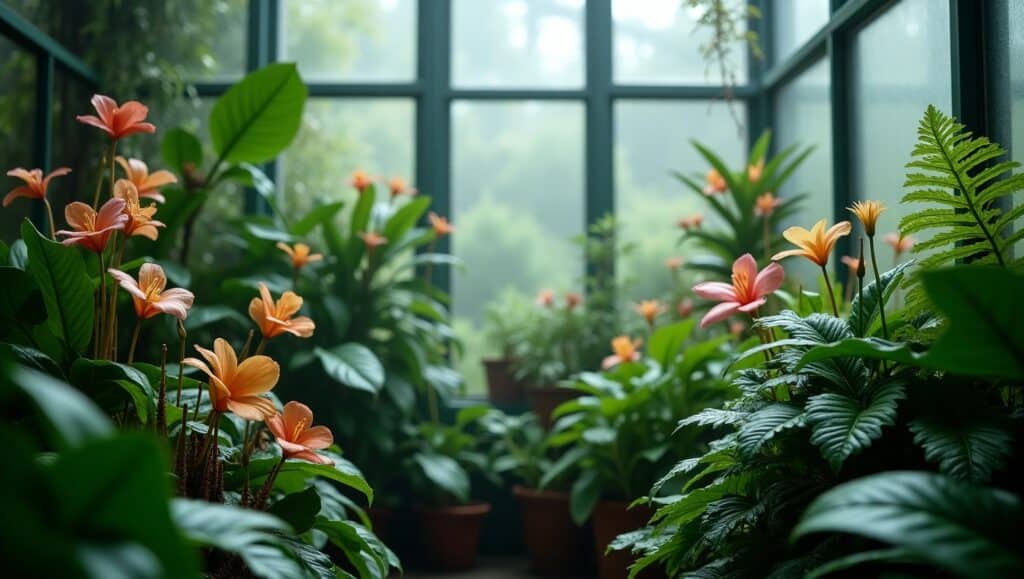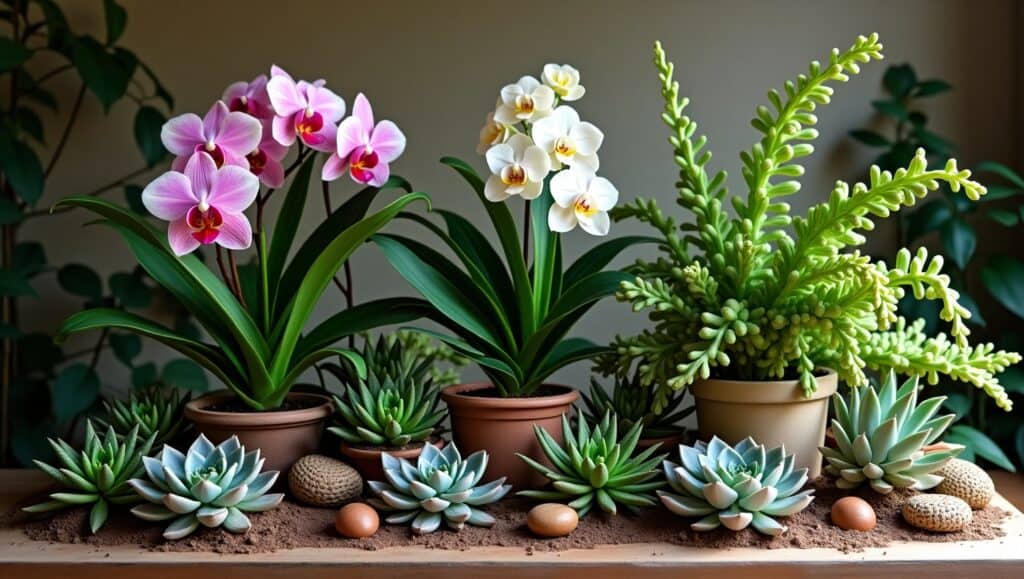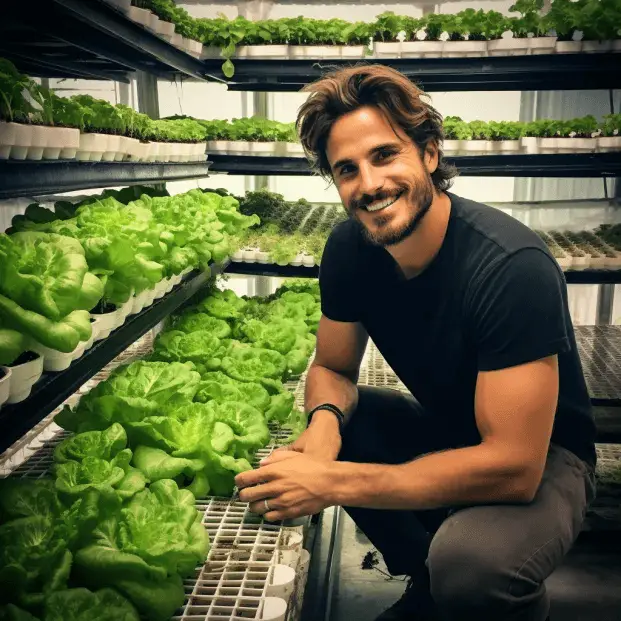High humidity environments can be tricky for growing plants. While plants need light to grow, too much moisture can cause problems like mold or root rot (1). Grow lights are a great solution! They provide the necessary light without adding extra humidity to the air.
When using grow lights in high humidity, it’s important to monitor both light and moisture levels. Some plants, like ferns and orchids, thrive in these conditions, while others, like succulents, prefer drier air.
Adjusting the light schedule and keeping an eye on temperature can help create the best environment. Fresh air is also essential to prevent mold. Keep reading for helpful tips on using grow lights in high humidity and learn which plants do best in these conditions!
Key Takeaway
- Grow lights help plants grow in high humidity.
- LED lights are good because they do not make much heat.
- Choosing the right plants is important for success.
Understanding High Humidity Environments

High humidity can be tricky for plants. It’s a delicate balance. Some plants thrive, while others struggle. If the soil stays too wet, root rot can happen. That’s where grow lights come in handy. They provide the light needed for photosynthesis without adding more moisture to the air. So, they’re a smart choice for humid spaces.
Types of Grow Lights
- LED grow lights are popular. They’re energy-efficient and don’t get very hot, which is great in humid areas. Brands like Spider Farmer and Samsung LM301H are known for their quality.
- On the other hand, fluorescent and HID grow lights produce more heat. This extra warmth can be a problem. It might require special cooling systems to keep plants safe.
Using the right lights can make all the difference. Proper light helps plants grow strong and healthy. Maybe trying LED lights in a grow tent would be a good start.
Considerations for High Humidity
Credits: CLtv
Temperature Control
Temperature control is key for plant health. Using grow lights can warm the air. This warmth can be good or bad. If it gets too hot, plants might suffer. Most plants prefer temperatures around 70 to 80 degrees Fahrenheit. Too much heat can cause leaves to curl or turn yellow. That’s a sign that something’s wrong.
Monitoring the temperature is smart. A thermometer placed near the plants helps keep track. If the air gets too warm, using fans can help. Fans keep air moving and prevent hot spots.I think finding the right balance is important. Plants need warmth, but not too much. Adjusting the light intensity or the distance can also help control heat.
Regular checks can make a big difference. Keeping that perfect temperature leads to healthier plants. It’s all about creating the right environment for growth.
Air Circulation
Air circulation is super important for plants. They don’t like to feel stuffy. When air moves around them, it keeps them healthy. Stagnant air can lead to mold, which is not good news (2).
Plants breathe through their leaves. If air isn’t moving, they might struggle. Fans can help a lot here. They create a gentle breeze that keeps air flowing. This is especially helpful in high humidity environments.
Maybe placing a fan near the grow lights could do the trick. It can help cool things down while keeping air moving. I think oscillating fans are a good choice. They spread air around evenly.
Checking for signs of mold is wise. If plants start looking fuzzy, it’s time to up the air circulation. Keeping air moving is a simple way to promote healthy growth. It can really make a difference in a grow tent or space.
Light Intensity and Distance
Sometimes, grow lights can be too strong for plants. If they are placed too close, it might hurt them. Plants can get scorched or stressed. That’s not what anyone wants.
Most lights need to be at least 12 to 24 inches away from the plants. This distance helps spread the light evenly without causing damage. Using lower wattage bulbs can also be a good idea. They provide enough light without the risk of burning leaves. For example, a 300-watt LED light might be perfect for a small grow space.
Checking how plants respond is smart. If leaves start to turn yellow or look crispy, it’s time to adjust the light. Experimenting with different heights can help, too. It’s all about finding the sweet spot for light exposure. Healthy plants need just the right amount of light to thrive.
Humidity Management
Grow lights don’t add moisture, but they can heat up the space quite a bit. This can be a double-edged sword. On one hand, the warmth can help plants grow. On the other hand, too much heat can make the air feel dry.
Checking humidity levels is really important. Plants like it when humidity stays around 40 to 60 percent. If the air gets too dry, plants might not thrive. They could show signs of stress, like drooping leaves.
Opening a window or using a humidifier can help. Fresh air is great for keeping things balanced. It brings in moisture and helps lower temperatures. I think rotating the plants occasionally can also be a good idea. This way, every plant gets a chance to feel the fresh air.
Monitoring both temperature and humidity can lead to healthier plants. It’s all about creating the right conditions for them to flourish.
Plant Selection

Ferns and Orchids
- Ferns: Ferns thrive in high humidity environments, with optimal humidity levels ranging from 60-80%. They require indirect light and benefit from grow lights that mimic natural sunlight2.
- Orchids: Orchids also love high humidity, typically between 50-70%. They need bright, indirect light, and grow lights can help them bloom more effectively (3).
Nerve Plants
- Nerve Plants (Fittonia albivenis): These plants prefer humidity levels above 50%, ideally between 60-80%. They thrive under fluorescent grow lights, which provide the necessary spectrum for healthy growth (4).
Succulents
- Succulents: While succulents are known for their drought tolerance, they can adapt to moderate humidity levels of 30-50%. High humidity can lead to issues like rot and fungal infections.
Knowing which plants enjoy humidity can help in creating a thriving environment. It’s all about matching the right plants with the right conditions for success.
Best Practices

Monitor Plant Health
Monitoring plant health is super important. Keeping an eye on them can help catch problems early. If plants start looking sad or sick, that’s a big red flag.
Signs of stress can show up in different ways. Leaves might droop, turn yellow, or even curl. These changes often mean something isn’t right.
Adjusting the lights or conditions can help fix these issues. If the lights are too close, moving them further away can prevent leaf scorch. On the other hand, if the air is too dry, adding humidity can help perk them up.
Regular check-ins are key. Spending a few minutes each day observing plants can make a big difference. It’s all about creating a happy environment for them. Healthy plants are usually a good sign of proper care and attention.
Adjust Lighting Schedules
Different plants have different light needs. Some love bright light, while others prefer a bit of shade. Understanding these needs is crucial for keeping plants healthy.
Adjusting the light schedule is a smart way to cater to each plant’s preferences. For example, leafy greens might thrive on 12 to 16 hours of light each day. On the other hand, flowering plants like orchids might need less, around 10 to 12 hours.
Changing the light schedule can also help plants grow better. If a plant seems to be stretching towards the light, it might need more time in the sun. If they look burnt or crispy, it could be too much light.
Observing how plants react to light is key. Some may need more or less light as they grow. Keeping track of their needs will help create a happy home for all kinds of plants. It’s all about finding the right balance for each one.
Maintain Optimal Conditions
Making sure the temperature, humidity, and air movement are just right is super important for plants to thrive. Each of these factors plays a big role in how happy and healthy plants can be.
Temperature is key. Most plants like it warm, usually between 65°F and 75°F. If it gets too hot or too cold, they might not grow well. Checking the temperature regularly can help catch any issues.
Humidity is another big factor. Many plants enjoy humidity levels between 40 to 60 percent. If the air is too dry, plants can struggle. Using a humidifier or misting the plants can help keep humidity levels where they need to be.
Air movement is also important. Fresh air helps prevent mold and keeps plants healthy. A gentle fan can create a nice breeze, which is great for air circulation.
Balancing these three elements can lead to thriving plants. It’s all about creating a comfortable environment where they can grow strong and healthy!
FAQ
Why do I need special grow lights for high humidity environments?
Grow lights for high humidity environments are essential because regular lights can’t handle moisture well. When you’re growing plants in humid indoor spaces or steamy environments, standard lights can get damaged. Using humidity-resistant grow light systems helps prevent electrical problems and keeps your plants growing safely.
How do waterproof grow lights protect against moisture damage?
Waterproof grow lights and moisture-resistant LED grow lights have special seals and coatings that keep water out. These lights work great in damp environments, foggy conditions, or misty greenhouses. Think of them like a rain jacket for your lighting – they keep working even when things get wet.
How do humidity-controlled grow lights work in greenhouses?
Humidity-controlled grow lights for greenhouses are designed to work in wet conditions. These high-moisture area lights include features that help manage condensation and prevent water damage. They’re perfect for foggy greenhouses and damp indoor spaces where regular lights might fail.
What’s the difference between water-resistant and waterproof grow light systems?
Water-resistant grow light systems offer basic protection against humidity, while waterproof grow light systems provide complete moisture protection. Water-resistant lights can handle light mist, while waterproof lights for wet conditions can handle direct water exposure. For high-humidity environments, waterproof options provide better protection.
What types of grow light fixtures work best for tropical plants?
Grow lights for tropical plants need to handle high moisture while providing proper light. Humidity-resistant LED grow lights, especially those designed for steamy environments, work best. Look for high-humidity plant grow light systems that can withstand constant moisture exposure.
Conclusion
Using grow lights in high humidity can help plants grow strong and healthy. You gotta pick the right types of lights and plants. Keeping an eye on conditions is key too. If the lights are too hot, they could hurt the plants, while too little light might stunt their growth. I think it’s important to experiment a bit. Every setup is different. So, find what works for you, and then—happy growing!
References
- https://pmc.ncbi.nlm.nih.gov/articles/PMC8306225/
- https://www.sciencedirect.com/science/article/abs/pii/S1537511016300447
- https://www.aos.org/orchid-care/humidity-for-plants
- https://greg.app/nerve-plant-humidity/#:~:text=Ideal%20Humidity%20Range%20for%20Nerve,leaves%E2%80%94cue%20the%20tiny%20violins.
Related Articles
- https://tophydroponicgarden.com/grow-lights/
- https://tophydroponicgarden.com/temperature-and-humidity-monitor/
- https://tophydroponicgarden.com/how-to-increase-light-intensity-for-hydroponic-systems/
- https://tophydroponicgarden.com/different-light-cycles-for-different-plants/
Was this helpful?

I’m Barrie L., a passionate hydroponic gardening enthusiast dedicated to cultivating thriving, soil-less gardens. With a focus on all things hydroponic, I share my expertise on innovative growing techniques and sustainable practices through my blog, tophydroponicgarden.com. As a seasoned hydroponics specialist, my goal is to inspire and guide fellow gardeners in harnessing the power of water-based cultivation for bountiful and eco-friendly harvests. I’m also an author of the book “Hydroponics For Absolute Beginners: Your Step By Step Guide For How To Create An Hydroponics System At Home Without Soil, For Growing Vegetable, Fruit And Herbs.” which is sold on Amazon. Join me on a journey of redefining the way we cultivate plants, one nutrient-rich solution at a time. Happy growing!


